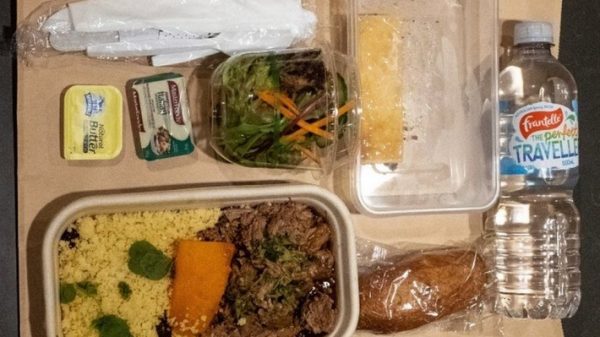Quarantine meals: The 2020 food trend no-one predicted

It is now almost laughable, reading back the list of the foods we would all be excited by in 2020.
Seacuterie, anyone? Monk fruit syrup reductions, or CBD-infused macaroni? Indeed, the only trend that made it from this list of “foods to watch” compiled by our colleagues late last year is the alternative flours – but that is only because the supermarket shelves were stripped of the regular kind.
However, I can guarantee none of them listed what I consider to be 2020’s major food trend: the quarantine meal, eaten by those of us lucky enough to spend two weeks trapped in a hotel room. They were left outside our locked doors three times a day by a person we never saw.
Across the world, people flew into quarantine facilities and were treated to mass catering which provided some truly weird and wonderful combinations – some of it good, some of it edible, and some of it best forgotten at speed.
“It was a positive spin on airplane food,” Henry Parham says of the regimen of blueberry muffins, eggs, and quiche which got left outside his room in Melbourne, Australia, after his return for the US earlier this year.
Lukewarm school dinners was the analogy I would have chosen for my own experience of quarantine food here in Singapore.
However, where we were agreed was that the food arriving at the door at least broke up the monotony of 15 days within the same walls.
“For me, it was the three most exciting times of the day. I never knew what we were getting,” Henry recalls.
I also never knew quite what was going to turn up, and my haphazard selections ended up producing some interesting and unexpected combinations, including a quinoa wrap and mashed potatoes, slabs of cold egg and drowned beans and, on one particularly memorable occasion, a tentacle and noodle combo with a smell so strong it was immediately ejected from the room.
There are other stories of horror which emerge while swapping stories with friends around the globe. A dal and noodle combination got one Sri Lankan particularly upset (why? she still cries, months on), while noodles received by a fellow Singaporean quarantiner were described as “looking like worms”. A colleague later analysed a picture of said noodles and declared they were actually known locally as rat’s tail noodles.
However, with three different cuisines to choose from in Singapore for each meal, we at least couldn’t complain about having to eat the same thing repeatedly.
The same cannot be said for Josy Fouché Guibon, who spoke to the BBC while she was just over a week into quarantining in Bergen, Norway.
“It’s a lot of pasta,” she says, exasperated. “Yesterday, we had pasta – again. I said no. I put it outside my door.
“When I am given a bit of vegetable or salad it is like I am in heaven.”
But she isn’t cross.
“It’s the government paying for the food,” she points out. “Of course, I understand they are doing it at the lower cost.”
Indeed, getting food to the thousands in quarantine – arriving from all over the world, with different tastes and preferences – is not an easy job.
But it is frustrating when you know there is such good food available just out of reach: Singapore, for example, is known for its amazing dishes – many of which I have since gulped down.
Josy, who had travelled to Norway to see family from her home in Biarritz, France, admits she had been hoping for “a lot of salmon” – hopes which had, so far, been dashed.
It’s just, she summarises, “so boring”.
But then it turns out it didn’t need to be this way: meet Sam Low, the award-winning New Zealand barista who dedicated his time to transforming the everyday into something, well, spectacular.
“It kind of went weirdly crazy and viral,” he says a few weeks after New Zealand Prime Minister Jacinda Ardern shared his Instagram pictures of his transformed quarantine meals.
Sam had arrived back from Australia forewarned, armed with scissors and cooking utensils after watching friends documenting their experiences.
And so, he set about turning his meals into small works of art – a far better pastime than Henry discovered, which revolved around reading the packaging of all of his food.
“I could never have imagined I would have become curious about the packaging,” Henry marvels. “It did make me reflect on it – the fact there is a whole supply chain involved. And then I would inhale it in 10 seconds.”
Sam was not inhaling his food in 10 seconds flat. His creations would take some time to put together, but they were quickly noticed.
“I was getting some communication with the chefs – it was nice chatting with them on Instagram. But I was still getting food exactly the same as everyone else.”
There was, however, a secret: the food which looked so good on camera was often not the most interesting to actually eat. Dry and bland are two words which pop up as he speaks.
“I think they did it on purpose to cater for every person,” Sam says.
Again, we could all have learned lessons from Sam. He did not just turn up with utensils. He also turned up with two secret ingredients: Kewpie Mayonnaise, and Lao Gan Ma chilli oil.
“I brought two of the world’s best-selling condiments with me,” he says, proudly, before summing up why he thinks his pictures were so popular.
“I think it was a positive message – you’ve got to make the best out of any circumstance and situation.”
Even so, I think we are all hoping quarantine meals will be one trend which remains in 2020.




























Leave a Reply